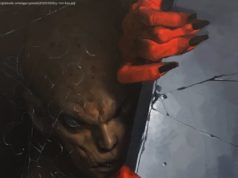Trimming a manuscript is much easier with the right pair of scissors.
It’s been a long time since I last reported on my novel’s progress, but it’s still coming along and presenting new challenges to be solved by hardware, software and scented candles.
I wrote my whole first draft – the block of clay to be carved, squished and beaten into a sculpture – using the distraction-free word processor FocusWriter. The result was a 90,000-word plain text document that’s full of ideas, but giant and unwieldy. I wanted a more holistic view – a way to see and tune chapters without losing sight of the overall structure (such as it is).
Scrivener isn’t cheap, but its organizing tools and various pinboards meant it seemed like the best software for the job. It’s a shame that the most recent version is only available for Mac, but Windows users can’t be choosers. On the chopping block
Dividing the raw text into chapters was much easier than I’d expected; Scrivener lets you import a giant file, then split it into chunks with a couple of clicks. You don’t have to copy and paste each scene individually, thank goodness. I’ve already worn out one laptop – I don’t want to destroy the C, V and Ctrl keys on this one.
I chopped my novel into scenes, then made a folder for each chapter and felt terribly pleased with myself – until I realized how many things needed rearranging. Now I have about 30 empty chapter folders and all my scenes in one long list. It was like sorting your trash for recycling, then finding out it’s all going in the same incinerator. Still, even destruction is a kind of progress – or so I keep telling myself.
It hasn’t quite come to this, but I have broken one laptop keyboard with enthusiastic typing
Editing is a far more technical process than writing, and not as fun as just letting all your ideas explode onto a blank page. It’s easy to feel like I’m treading water, and sometimes I definitely am. After spending a particularly long time rewriting one early scene, I re-read the original and saw that I hadn’t made it better in any objective way – just differently bad.
I’ve also deleted about 18,000 words (I got seriously carried away with describing a couple of locations), leaving giant gaps that need filling with fresh, interesting new material. I know what needs to go in those holes, but when I’m not working in chronological order, one chapter to the next, it can be hard to find my flow. Old software, new ideas
Although Scrivener offers its own little no-frills writing app, FocusWriter still feels like the best place to be creative. When I see its familiar, slightly cheesy faux-wood background (I never changed it from the default), the ideas suddenly start to come much more easily.
The Evernote app is brilliant too. The best thoughts often bubble up when I’m not looking for them, and it means I can quickly jot them down on my phone before they burst. Any note-taking app would do, but I’m also fond of Evernote’s browser extension, which lets you clip interesting web pages (or screenshots) for future reference with a single click.
The muse might visit me even more readily if I light the Oscar Wilde candle again. Alternatively, it might just make the room smell like herbal aftershave, and my novel will end up being set in a dystopian barbershop. Either way, it’ll be something novel. Cat Ellis has turned to technology to help write her first novel. Follow her progress in her Sculpt Fiction column. The best free software for writers






